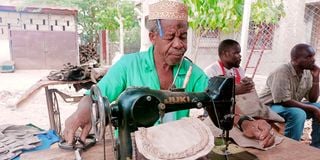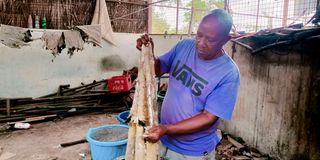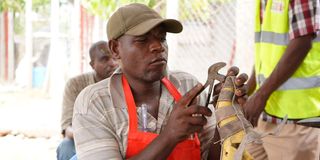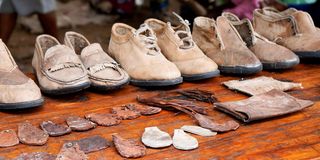Premium
Group is determined to revive leather production in Hola

The group is looking for partners who will help them put up a modern factory on their piece of land, a factor that will make their trade much easier.
On the streets of Hola town in Tana River County, a group of elderly men and women are revisiting the history of leather tanning.
Amid a multitude of colours and strong odours, the group is busy turning hide into leather, which they will then use to make shoes, caps, bags and wallets.
Their methods date back to several centuries ago, a time-consuming and labour-intensive task which they hope to simplify in the near future.
Joseph Mbaru, the chairman of the Hola Juakali Tannery, is among the elderly founders of the small factory which has been running for nearly two decades.
“We started with five people and later grew to 10, we are currently 45 people since we decided to bring on board some youthful people so that we may pass on the craft to them,” Mbaru says.
To find the tannery, all you have to do once you get to Hola town is follow the smell of hide that fills the air. To Mbaru, the tannery is a triumph, not because it is especially financially rewarding, but because it is finally up and running after more than five years in slumber.
“We started this more than two decades ago but stopped after most of our colleagues became sick. At the time, we were only doing leather tanning and selling to potential buyers, we did not produce products out of it,” he recounts.

Joseph Mbaru, the chairperson of the group, inspects hide.
The process relies on chemicals that pose health hazards to him and his co-workers, leading to a majority walking away, risking losing the ancient craft. The group works with goat, sheep, and cow hide, which they source from local abattoirs for free since the hide market long died here.
“We used to buy it for Sh150 for goat and sheep hide and about Sh300 for cow hide when the market was alive,” says Mbaru.
They start by soaking the hide in a tank with a mixture of lime and water for 72 hours to soften it for removal of fur. The hide is then later transferred to another tank with a mixture of water and ammonium sulfate for 24 hours to remove the lime and later to a mixture of battery acid, water and common salt for another 24 hours to make the fibers of the hides more receptive to tanning in a process referred to as pickling, where they immerse the hide in tannin and pickle liquor for 72 hours, and then begin turning the hide into leather.
The process then moves to basification where a solution of water and baking powder is used to reduce the pH of the leather hence reducing the shrinking. Mbaru explains that this process fixes the tanning material into leather, and the more the tanning material is fixed, the higher the hydrothermal stability and increased shrinkage temperature resistance of the leather.
“After this, we dye the leather using a very versatile compound called Mimosa, this compound delivers the rapid penetration of the tannin into the leather resulting in a smooth hide with light fatness,” he explains.

A youth designs shoes at the Jua Kali Centre in Hola, Tana River County.
The process then moves to fatliquoring where oil is introduced to the leather to soften it further. Cooking oil, water, and bar soap are used to make an emulsion for this process. The leather is then hung overnight to reduce moisture and later toggled to stretch the fiber. It is a tedious job that can take an entire day to finish just two pieces of leather to satisfactory standards. The leather is then moved to the design and product processing wing where another team of young men and women led by an elder come up with designs for shoes, wallets, belts, and sling bags.
Fatuma Haboya Abdi is among the young women tasked with designing and cutting the leather to suit a particular product.
Fatuma, a trained design and tailoring expert from the Hola Vocational Training Center uses her knowledge to come up with good fits.
“It is a rare skill, and for elders like these to trust you with the artwork, it is an honour for me, so I strive to deliver something that can sell in the market,” she says.
However, she notes that it is not an easy job as more research requires the internet, which is not available for her and the team she leads. Market accessibility has also not been easy.

Shoes, belts, wallets and purses.
In a good month, they make Sh54,000 from their craft, and when the market is down, they make Sh22,000 in a month with shoes for men and sling bags being their best sell.
The group still suffers a huge gap in terms of equipment to deliver a perfect, finished product and also reduce the health risks associated with leather processing.
To deal with these challenges, the group is in search of partnerships that will support them to market their products as well as establish a bigger and more modern factory on their 10-acre piece of land in the outskirts of Hola, where they can also pass on their skills to young people besides creating employment for them.





